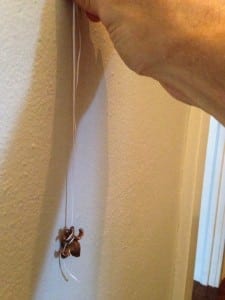 If you own an old house with plaster and lath walls, you may have discovered how utterly useless a stud finder can be. Most smaller items can be hung pretty securely anywhere on the wall by screwing into the wood lath, but for heavy things that weight more than 10-15 lbs, like large mirrors and TVs, you’ll need to learn how to find studs in a plaster wall.
If you own an old house with plaster and lath walls, you may have discovered how utterly useless a stud finder can be. Most smaller items can be hung pretty securely anywhere on the wall by screwing into the wood lath, but for heavy things that weight more than 10-15 lbs, like large mirrors and TVs, you’ll need to learn how to find studs in a plaster wall.
Don’t waste your money on that stud finder. Try these simple and time tested tricks to find studs in a plaster wall the next time you need to hang something in your old house. The third trick is my personal favorite because it never fails!
#1 Find an Electrical Box
Electrical boxes for outlets and light switches are supposed to be attached to studs. Though there may be an occasional free floating box in an old home, you have an excellent chance of finding a stud on one side of the box. To see which side the stud is on, take the switch plate cover off and take a peak inside. Either turn the breaker off, or be careful not to touch any wires before attempting this or you can get a nasty shock.
Once you find the stud, you can measure off 16″ to find the next one most times. Most houses built in the last 100 years were framed 16″ O.C. (on center) and some were framed 24″ O.C. although many old houses may have unusual stud spacing so this method may not work for everyone.
#2 Knock on the Wall
This one may seem old fashioned, but gently knocking your hand along the wall and listening for differences is a pretty accurate technique to find studs. When you knock on wall sections without a stud, you will hear more resonance from the hollow space behind. Once your knuckle hits the spots where a stud is located, the sound will change to more of a dull thud. Move along the wall and look for a pattern to show itself, and you’ll slowly be able to see your stud spacing.
#3 Use a Magnet

This is my favorite method and the reason is simple. It works every time! Grab the strongest magnet you have and tie a piece of dental floss or string around it. Dangle the magnet against the wall and slowly move it horizontally across the wall. You have to go slow. Every so often, the magnet will stick to the wall a bit on the stud location. It has to be a strong magnet for this to work, so those floppy pizza magnets won’t cut it.
The reason this works is because the wood lath is nailed to the studs, and the magnet is attracted to those nails. Keep in mind there are some spaces between lath vertically so if you’re not having much luck try moving the magnet up or down a bit so that it is over top one of the hidden nails.
Update: Since I first wrote this post we have begun offering a totally cool new product called StudPop which takes the magnet trick to the next level. This simple stud finder is a powerful magnet that pops into place when a stud fastener is detected. Just like my magnet trick, but a bit more refined than tying dental floss around a magnet. Check it out here!
#4 Use a Metal Detector
If you happen to have a small metal detector, you can use this along the same premise as the magnet technique. Beware that depending on the sensitivity of your metal detector you may pick up old wiring, cast iron plumbing, or other things hiding in the wall. Unlike the magnets which aren’t strong enough to be attracted to a pipe that is a couple inches recessed into the wall the metal detector may give you false readings.
So, there you have it. No more fumbling with expensive stud finders that give you all kinds of weird readings. Other than the metal detector, these techniques have been used for decades to find studs in plaster walls. The best part? They cost you almost nothing. And saving money is an important thing with all the other repairs lingering in an old house.

Founder & Editor-in-Chief
I love old houses, working with my hands, and teaching others the excitment of doing it yourself! Everything is teachable if you only give it the chance.

My 1930s home has plaster walls, but I do not believe they have wood lath (rock lath perhaps?). I have been hanging some shelves in my son’s room. I used the magnet trick and successfully found some studs to help me with my project. However, one of his walls I absolutely cannot detect a stud. This is an exterior wall. His room is directly above the fireplace in our downstairs family room. Therefore, the chimney runs up along this side of our house and this is the wall I cannot detect a single stud. So to be clear, the brick chimney is directly behind this wall. Is it possible there are not studs? Doesn’t make sense to me! Help!
If you can drill directly into brick, why would you need the studs.. It could be that the laths are on much lighter timbers to create a shallow gap? I’ve hung very heavy stuff- including a radiator – using frame fixings straight into the brick beyond the plaster…
That magnet trick is awesome! Saved this 20something a hassle:) thanks!!
Awesome Anna!
Thank you sir. Stud finder was inconsistent but I had a magnet hanging on the wall by itself! String really adds to the sensitivity. Brilliant. Thank you so much for this cool method.
If you can find any rare earth magnets these work great and will hold themselves right to the wall as you search for additional nails. I have a few of these from some of my old fish tanks and they work terrific (even on the ceiling).
Wow! This is a great guide for me. I’ve learned something from this. Looking forward to read more of your post and updates in the future
If you need a stronger magnet, you won’t find stronger ones than the ones they put in computer hard drives. So go buy a worthless old hard drive (not an SSD, a magnetic, spinning drive), take it apart and enjoy the super powerful magnets therein.
#3 is awesome. Thank you!
Thank you, thank you! I have a 1900-something house and have been doing the method of drilling small holes to find studs. It’s annoying to fill in the holes, but that works, too.
Old houses have character, but they sure have mystery as well!
This is brilliant, I have two stud finders that don’t cut it. I have an amazing 4 inch long bullet shaped magnet that my dad acquired year’s ago. Mom used it to find pins from sewing. Now I’ll be using it to find studs!
So simple and obvious I now feel stupid for buying all these electronic stud finders.Great info…Thanks
you can purchase small,simple, inexpensive magnetic stud finders at hardware stores – they are built on a pivot so that you can see when the magnet is attracted to a nail:) Also, if your ceiling or wall is textured, you can hold a piece of paper between the stud finder (of any type) and the wall, and slide the stud finder on the paper. Works like a charm:)
This explains so much! I found a stud using my electric box, and when I drilled, I hit metal. I thought maybe it was a conduit and stopped. It must have been the head of a nail holding the lath in. I’m trying the magnet method from now on.
I’m trying to find a stud on an exterior plaster wall that is a shear wall. I’m going to be hanging an awning over a window. Any Suggestions?
Try finding the stud on the interior and measuring the distance to a casing so you can transfer the measurement to the exterior.
Thank you so much for this! I’ve been wanting to hang a pot rack in my kitchen but try as I might I haven’t been able to locate a stud with a stud finder or by rapping on the walls. I just tested your magnet method and it worked! It appears I have studs every 18 inches. However, I think this may be difficult on the ceiling. Any suggestions?
Sherri, I’ve never tried the ceiling, maybe try a more powerful magnet and try hovering it with your hand until you feel a bit of a pull.
Awesome, the magnet trick worked! I very strong magnet is needed. Thank you!
For YEARS to find studs in plaster and lath wall I would drill a hole insert a long thin wire in the wall to find the stud. The magnet works so much better. It seems so simple but sometime U need to be told. Using the strongest magnet you can find is better. Earth Magnet or magnet from a PC Hard Drive are very strong.
Home owners ought to make repairs employing a top spec roof cement, for example Henry 208 Wet Patch Roof Cement, which can be discovered at hardware
stores and home centers. If you choose to hire a
roofing contractor who’s experienced in flat roof repairs, make certain
to discover their company history information just before obtaining the business.
The reason for the free consultation and advice is to
help you make an informed decision on the choices of roofing materials
and designs that exist for you.
Any suggestions for textured plaster walls with the wire/mesh lathing?
Posted a video of the “Magnet” technique on my website. Here is the link to the article …
These are great tricks! My husband has having trouble trying to find the studs in our old house, so I’ll have to suggest the magnet trick to him! Thanks!
toni
Glad to help Toni!